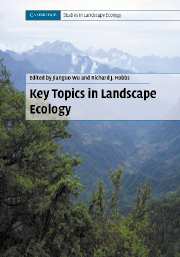Book contents
- Frontmatter
- Contents
- List of contributors
- Preface
- PART I Introduction
- PART II Key topics and perspectives
- 2 Adequate data of known accuracy are critical to advancing the field of landscape ecology
- 3 Landscape pattern analysis: key issues and challenges
- 4 Spatial heterogeneity and ecosystem processes
- 5 Landscape heterogeneity and metapopulation dynamics
- 6 Determining pattern–process relationships in heterogeneous landscapes
- 7 Scale and scaling: a cross-disciplinary perspective
- 8 Optimization of landscape pattern
- 9 Advances in detecting landscape changes at multiple scales: examples from northern Australia
- 10 The preoccupation of landscape research with land use and land cover
- 11 Applying landscape-ecological principles to regional conservation: the WildCountry Project in Australia
- 12 Using landscape ecology to make sense of Australia's last frontier
- 13 Transferring ecological knowledge to landscape planning: a design method for robust corridors
- 14 Integrative landscape research: facts and challenges
- PART III Synthesis
- Index
- References
6 - Determining pattern–process relationships in heterogeneous landscapes
Published online by Cambridge University Press: 12 January 2010
- Frontmatter
- Contents
- List of contributors
- Preface
- PART I Introduction
- PART II Key topics and perspectives
- 2 Adequate data of known accuracy are critical to advancing the field of landscape ecology
- 3 Landscape pattern analysis: key issues and challenges
- 4 Spatial heterogeneity and ecosystem processes
- 5 Landscape heterogeneity and metapopulation dynamics
- 6 Determining pattern–process relationships in heterogeneous landscapes
- 7 Scale and scaling: a cross-disciplinary perspective
- 8 Optimization of landscape pattern
- 9 Advances in detecting landscape changes at multiple scales: examples from northern Australia
- 10 The preoccupation of landscape research with land use and land cover
- 11 Applying landscape-ecological principles to regional conservation: the WildCountry Project in Australia
- 12 Using landscape ecology to make sense of Australia's last frontier
- 13 Transferring ecological knowledge to landscape planning: a design method for robust corridors
- 14 Integrative landscape research: facts and challenges
- PART III Synthesis
- Index
- References
Summary
Introduction
Landscapes are now being altered at unprecedented rates (Forman and Alexander 1998), resulting in the loss and fragmentation of critical habitats (Gardner et al. 1993), declines in species diversity (Quinn and Harrison 1988, Gu et al. 2002), shifts in disturbance regimes (He et al. 2002, Timoney 2003), and threats to the sustainability of many ecosystems (Grime 1998, Simberloff 1999). Because the ecological consequences of landscape change are difficult to measure, especially at broad spatial and temporal scales, the quantification of landscape pattern has often been used as an indicator of potential biotic effects (e.g., Iverson et al. 1997, Wickham et al. 2000). It is hardly surprising, therefore, that the development of methods to measure landscape pattern has become an important endeavor in landscape ecology (see O'Neill et al. 1999 for a recent review).
Numerous landscape metrics have been developed and applied over the last 15 years or so, but relatively few studies have been successful in using metrics to establish pattern–process relationships at landscape scales. The first landscape metrics paper (Krummel et al. 1987) attempted to do this by presenting the hypothesis that the shape of small forest patches should be affected by human activities while large patches should follow natural topographic boundaries. The analytical results showed that this was the case, but causal relationships were never experimentally confirmed.
Information
- Type
- Chapter
- Information
- Key Topics in Landscape Ecology , pp. 92 - 114Publisher: Cambridge University PressPrint publication year: 2007
References
Accessibility standard: Unknown
Why this information is here
This section outlines the accessibility features of this content - including support for screen readers, full keyboard navigation and high-contrast display options. This may not be relevant for you.Accessibility Information
- 4
- Cited by
